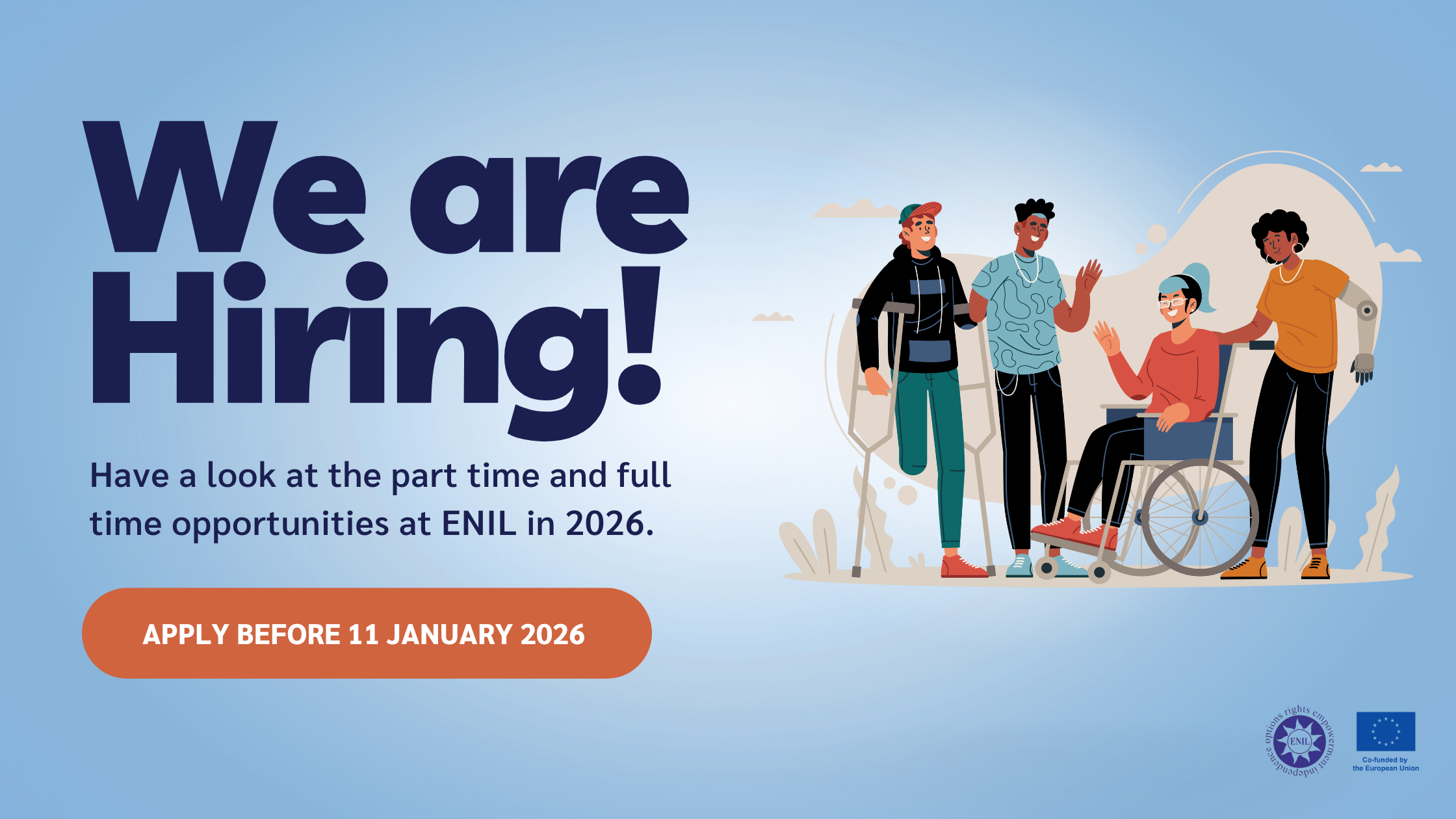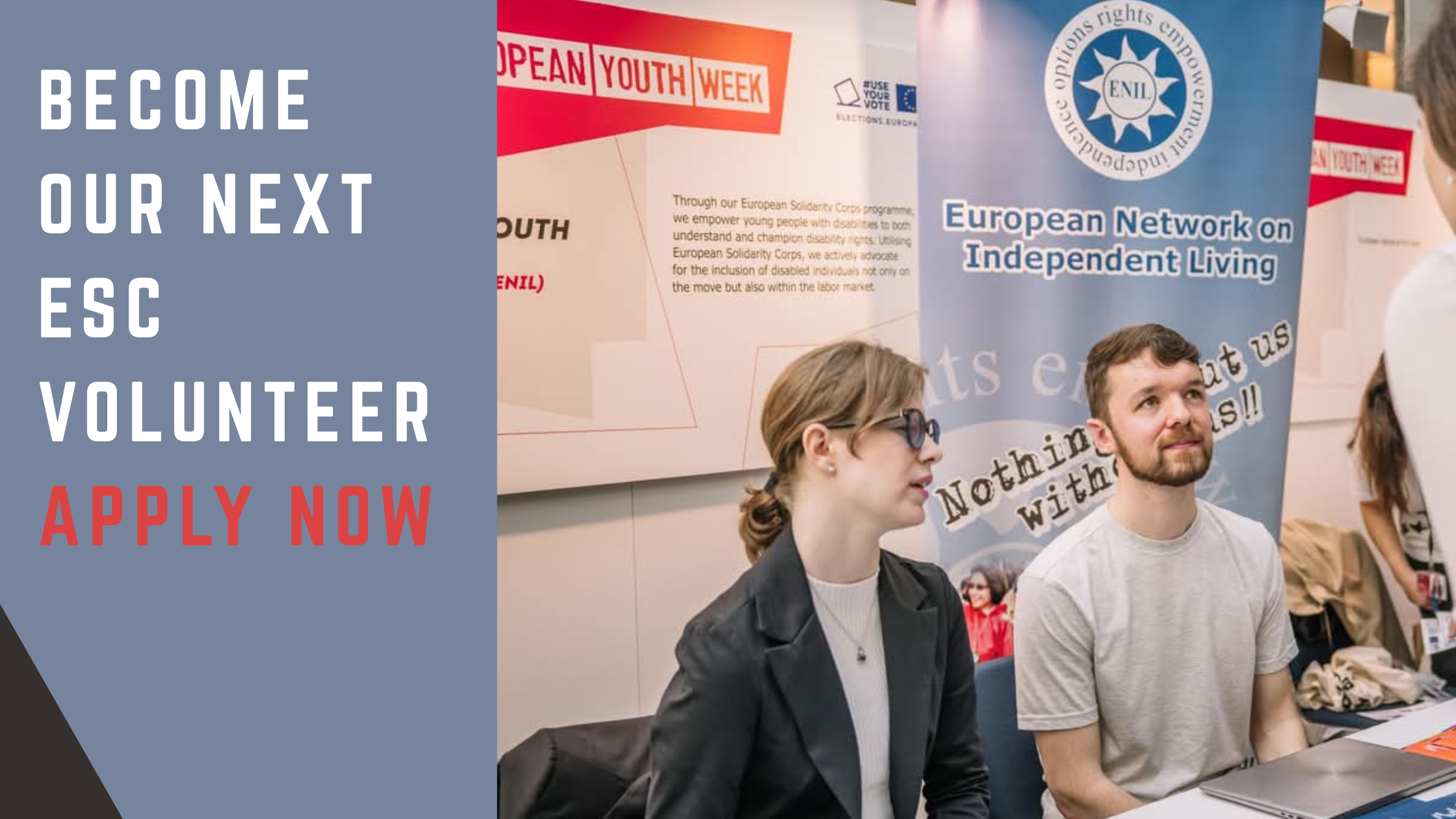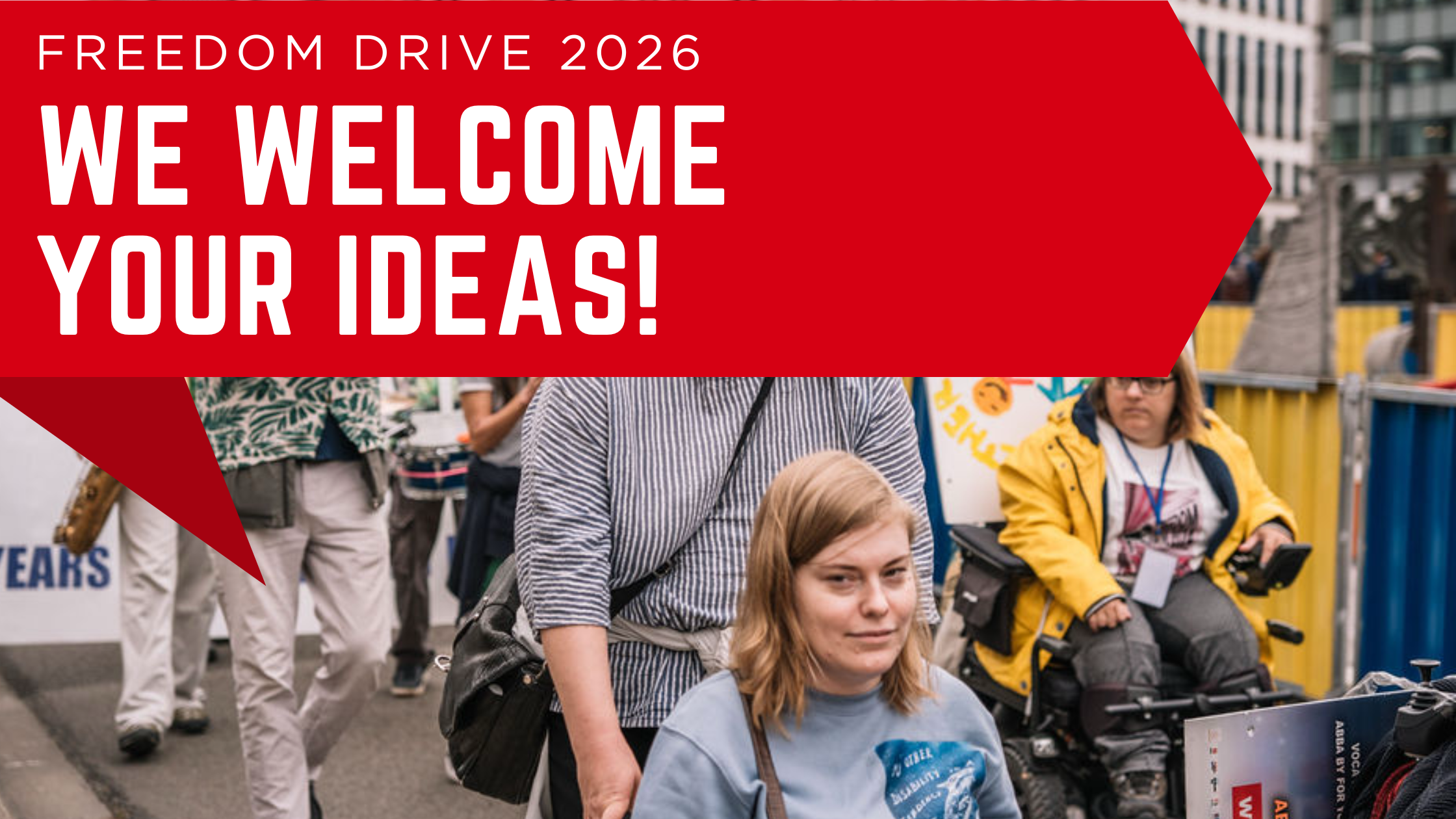Independent Living (IL) Reading List
(updated May 2024)
The IL Reading List is created and maintained by the European Network on Independent Living (ENIL) and reflects ENIL’s mission, values and priorities. The list may also contain references to papers that criticise the ideas and practices of Independent Living because we believe that being aware, willing and able to respond to such critiques makes the IL movement stronger.
Contents
- Personal assistance; direct payments
- CRPD
- Deinstitutionalisation
- Independent living
- Independent living across the world
- Capacity and supported decision-making
The IL Reading List is a work in progress and does not claim to be comprehensive – the field of IL-related knowledge is vast. We intend to update the list on an ongoing basis, adding new items and topics – as an example, in the near future, we intend to add references to papers on peer support and disability hate crime. People who have suggestions for new references that may be added to the list or for corrections of the existing entries could send their ideas to secretariat@enil.eu.
Personal assistance; direct payments
Barnes, C. (2007) ‘Direct payments and their future: an ethical concern?’ Ethics and Social Welfare, 1:3, 348-354. DOI: 10.1080/17496530701603095
Brennan, C., Traustadóttir, R., Anderberg, P. and Rice. J. (2016) ‘Are cutbacks to personal assistance violating Sweden’s obligations under the UN Convention on the Rights of Persons with Disabilities?’, Laws, 5:23, 1-15. DOI: 10.3390/laws5020023.
Chou, Y., Chen, B., and Kröger, T. (2023) ‘Lost in translation: implementing personal assistance in an East Asian context’, Disability & Society, 38:4, 587-609, DOI: 10.1080/09687599.2021.1930517
DeJong, G., Batavia, A. I. and McKnew, L. B. (1992) ‘The independent living model of personal assistance in national long-term-care policy’, Generations: Journal of the American Society on Aging, 16:1, 89-95. DOI: 10.4324/9781315227634-20
ENIL (2022) Myth Buster on Personal Assistance. Brussels: European Network on Independent Living. https://web.archive.org/web/20231110105315/https://enil.eu/wp-content/uploads/2023/06/Myths-Buster_Personal-assistance_web_low-res-1.pdf.
Graby, S. D. (2018) Personal Assistance: The Challenge of Autonomy. PhD thesis. Leeds: University of Leeds.
JAG (2011) The “JAG-model”. Personal Assistance with Self-Determination. Stockholm: The JAG Association. https://web.archive.org/web/20231110130140/https://enil.eu/wp-content/uploads/2022/03/Pa-manual_ENG.pdf.
Jolly, D. (2009) ‘ENIL Position Paper 2009/02. Personal Assistance and Independent Living: Article 19 of the UN Convention on the Rights of Persons with Disabilities’, online publication. Brussels: European Network on Independent Living. https://web.archive.org/web/20231110131627/https://www.mcgill.ca/humanrights/files/humanrights/enil-position-paper_personal-assistance-independent-living.pdf.
Manji, K. (2018) ‘“It was clear from the start that [SDS] was about a cost cutting agenda.” Exploring disabled people’s early experiences of the introduction of Self-Directed Support in Scotland’, Disability & Society, 33:9, 1391-1411. DOI: 10.1080/09687599.2018.1498767
Mladenov, T. (2020) ‘What is good personal assistance made of? Results of a European survey’, Disability & Society, 30:1, 1-24. DOI: 10.1080/09687599.2019.1621740
Mladenov, T., Pokern, Y. and Cojocariu, I. B. (2019) PA Checklist – A Tool for Assessing Personal Assistance Schemes. Brussels: European Network on Independent Living. https://web.archive.org/web/20231110153618/https://enil.eu/wp-content/uploads/2022/03/Mladenov_Pokern_Bulic-PA_Checklist.pdf.
Modic, K., Pečarič, E. and Retelj, D. (2023) Personal Assistance: Handbook for Understanding Independent Living. Ljubljana: YHD. https://web.archive.org/web/20231110153739/https://yhd-drustvo.si/wp-content/uploads/2023/06/OA-PRIROCNIK_e-izdaja_ANGLESKA-VERZIJA_14_06_2023_KONCNA-VERZIJA-ZA-OBJAVO.pdf.
Oliver, M. and Zarb, G. (1992) Greenwich Personal Assistance Schemes: An Evaluation. London: Greenwich Association of Disabled People’s Centre for Independent Living.
Priestley, M., Riddell, S., Jolly, D., Pearson, C., Williams, V., Barnes, C. and Mercer, G. (2010) ‘Cultures of welfare at the front line: implementing direct payments for disabled people in the UK’, Policy & Politics, 38:2, 307-324. DOI: 10.1332/030557309×477956
Ratzka, A. (2019) ‘What is personal about personal assistance: The difference between personal assistance and other community-based services. A personal comment on personal assistance’, Fukushi-Rodo, No. 162, Gendai Shokan, Tokyo. https://www.ratzka.se/lectures-in-english/.
Ratzka, A. (2004) ‘Model national personal assistance policy’, online publication. Stockholm: Independent Living Institute. https://web.archive.org/web/20231110165919/https://www.independentliving.org/docs6/ratzka200410a.pdf .
Ratzka, A. (1996) ‘STIL, the Stockholm Cooperative for Independent Living’, online publication. Stockholm: Independent Living Institute. https://web.archive.org/web/20231110170022/https://www.independentliving.org/docs3/stileng.html.
Ratzka, A. (1993) ‘The user cooperative model in personal assistance: The example of STIL, the Stockholm Cooperative for Independent Living’, online publication. Stockholm: Independent Living Institute. https://web.archive.org/web/20231110170118/https://www.independentliving.org/docs5/ratzka199301.html.
Shakespeare, T., Porter, T. and Stӧckl, A. (2017) Personal Assistance Relationships: Power, Ethics and Emotions. Report on ESRC Project ES/L007894/1. Norwich: University of East Anglia.
Westberg, K. (2010) Personal Assistance in Sweden, trans. S. Berg. Stockholm: Independent Living Institute. https://web.archive.org/web/20231110173659/https://www.independentliving.org/files/Personal_Assistance_in_Sweden_KW_2010.pdf.
Elder-Woodward, J. (2023) Current issues bulletin: Personal Assistance in Scotland: A Postcolonial Perspective, International Journal of Disability and Social Justice, 3:1, 114–120. https://www.jstor.org/stable/48724370.
CRPD
Committee on the Rights of Persons with Disabilities (2022) Guidelines on Deinstitutionalization, Including in Emergencies. CRPD/C/5. Geneva: United Nations. https://www.ohchr.org/en/documents/legal-standards-and-guidelines/crpdc5-guidelines-deinstitutionalization-including.
Committee on the Rights of Persons with Disabilities (2017) General Comment No. 5 (2017) on Living Independently and Being Included in the Community. CRPD/C/GC/5. Geneva: United Nations. https://www.ohchr.org/en/hrbodies/crpd/pages/gc.aspx.
Committee on the Rights of Persons with Disabilities (2014) General Comment No. 1 (2014) – Article 12: Equal Recognition Before the Law. CRPD/C/GC/1. Geneva: United Nations. https://www.ohchr.org/en/hrbodies/crpd/pages/gc.aspx.
ENIL (2022) Shadow Report on the Implementation of the UN Convention on the Rights of Persons with Disabilities in the EU. Brussels: European Network on Independent Living. https://web.archive.org/web/20231110105613/https://enil.eu/wp-content/uploads/2022/03/ShadowReport_EU_Final_140222.pdf.
Gooding, P. (2018) ‘The right to independent living and being included in the community: Lessons from the United Nations’, International Journal of Mental Health and Capacity Law, 24, 32-54. DOI: 10.19164/ijmhcl.v2018i24.747
Harpur, P. (2012) ‘Embracing the new disability rights paradigm: the importance of the Convention on the Rights of Persons with Disabilities’, Disability & Society, 27:1, 1-14. DOI: 10.1080/09687599.2012.631794
Moriarity, L. and Dew, K. (2011) ‘The United Nations Convention on the rights of persons with disabilities and participation in Aotearoa, New Zealand’, Disability & Society, 26:6, 683-697. DOI: 10.1080/09687599.2011.602861
Sperrin, Á. (2023) ‘A Disability Rights Approach to a Constitutional Right to Housing’, International Journal of Disability and Social Justice, 3:1, 80–95. https://www.jstor.org/stable/48724368.
Deinstitutionalisation
Ad Hoc Expert Group on the Transition from Institutional to Community-based Care (2009) Report of the Ad Hoc Expert Group on the Transition from Institutional to Community-based Care. Brussels: European Commission. http://ec.europa.eu/social/BlobServlet?docId=3992&langId=en.
Altermark, N. (2019) Citizenship Inclusion and Intellectual Disability: Biopolitics Post-Institutionalisation. London: Routledge.
Ben-Moshe, L. (2020) Decarcerating Disability: Deinstitutionalization and Prison Abolition. Minneapolis, MN: University of Minnesota Press.
Committee on the Rights of Persons with Disabilities (2022) Guidelines on deinstitutionalization, including in emergencies. https://www.ohchr.org/en/documents/legal-standards-and-guidelines/crpdc5-guidelines-deinstitutionalization-including.
Davis, A. (2003) Are Prisons Obsolete? New York, NY: Seven Stories Press.
EEG (2014) Toolkit on the Use of European Union Funds for the Transition from Institutional to Community-based Care. Brussels: European Expert Group on the Transition from Institutional to Community-Based Care. https://deinstitutionalisationdotcom.files.wordpress.com/2017/07/toolkit-10-22-2014-update-web.pdf.
EEG (2012) Common European Guidelines on the Transition from Institutional to Community-based Care. Brussels: European Expert Group on the Transition from Institutional to Community-Based Care. https://deinstitutionalisationdotcom.files.wordpress.com/2017/07/guidelines-final-english.pdf.
Fylkesnes, I. (2021) ‘Institutional talk and practices: A journey into small group-homes for intellectually disabled children’, Disability & Society, 36:6, 999-1020. DOI: 10.1080/09687599.2020.1779037
Gevorgianiene, V. and Sumskiene, E. (2017) ‘P.S. for post-Soviet: a glimpse to a life of persons with intellectual disabilities’, Journal of Intellectual Disabilities, 21:3, 235-247.
Goffman, E. (1974 [1961]) Asylums: Essays on the Social Situation of Mental Patients and Other Inmates. Harmondsworth: Penguin Books.
Human Rights Watch (2016) “It is My Dream to Leave This Place” – Children with Disabilities in Serbian Institutions. New York: Human Rights Watch. https://www.hrw.org/sites/default/files/report_pdf/serbia0616web_0.pdf
Ignatieff, M. (1983) ‘Total institutions and working classes: a review essay’, History Workshop Journal, Vol. 15, No. 1, pp. 167-173.
Kozma, A., Petri, G., Balogh, A. and Birtha, M. (2016) The Role of EU Funding in Deinstitutionalisation (DI) in Hungary and the Experiences of the DI Programme so far. Executive Summary. Budapest: Hungarian Civil Liberties Union. https://hclu.hu/files/tasz/imce/zarotanulmany_tasz_a4_en_preview_1_0.pdf.
Mansell, J., M. Knapp, J. Beadle-Brown, and J. Beecham (2007) Deinstitutionalisation and Community Living – Outcomes and Costs: Report of a European Study. Volume 2: Main Report. Canterbury: Tizard Centre, University of Kent. https://web.archive.org/web/20231110143258/https://research.kent.ac.uk/tizard/wp-content/uploads/sites/2302/2019/01/DECLOC_Volume_2_Report.pdf.
MDAC [Mental Disability Advocacy Centre] (2017) The Charm Toolkit: The Child Human Rights Abuse Removal Monitoring Toolkit. Budapest: Mental Disability Advocacy Centre. http://mdac.org/sites/mdac.info/files/charm_en.pdf.
Mladenov, T. and Petri, G. (2019) ‘Independent living in Central and Eastern Europe? The challenges of postsocialist deinstitutionalisation’, in I. Fylling, L. Baciu and J. Breimo (eds) EU Social Inclusion Policies in Post-Socialist Countries: Top-Down and Bottom-Up Perspectives on Implementation. London: Routledge, pp. 16-34.
Office of the UN Hight Commissioner for Human Rights (2023) Good practices of support systems enabling community inclusion of persons with disabilities. Geneva: OHCHR.
Office of the High Commissioner for Human Rights (2011) Forgotten Europeans – Forgotten Rights: The Human Rights of Persons Placed in Institutions. Geneva: OHCHR. http://www.europe.ohchr.org/Documents/Publications/Forgotten_Europeans.pdf.
Šiška, J. and Beadle-Brown, J. (2020) Transition from Institutional Care to Community-Based Services in 27 EU Member States: Final report. Brussels: European Expert Group on the Transition from Institutional to Community-Based Care. https://web.archive.org/web/20231110172055/https://www.inclusion-europe.eu/wp-content/uploads/2020/01/eeg-di-report-2020-1.pdf.
Sumskiene, E. and Orlova, U. L. (2015) ‘Sexuality of “dehumanized people” across post-Soviet countries: patterns from closed residential care institutions in Lithuania’, Sexuality & Culture, 19:2, 369-387. DOI: 10.1007/s12119-014-9262-1
Szasz, T. (1991 [1969]) Ideology and Insanity: Essays on the Psychiatric Dehumanization of Man. Syracuse, NY: Syracuse University Press.
Independent Living
Angelova-Mladenova, L. (2017) The right to live independently and be included in the community: addressing barriers to independent living across the globe.Brussels: ENIL.https://enil.eu/wp-content/uploads/2022/03/The-right-to-live-independently_FINAL.pdf
Barnes, C. (2004) ‘Independent living, politics and implications’, online publication. https://web.archive.org/web/20231110175631/https://disability-studies.leeds.ac.uk/wp-content/uploads/sites/40/library/Barnes-Janes-paper.pdf.
Bezmez, D. and Porter, T. (2022) ‘Disabled women’s care experiences in Turkey: intimacy, dependency, independent living’, Scandinavian Journal of Disability Research, 24:1, 54-67. DOI: 10.16993/sjdr.852.
Brennan, C. S., Allen, S., Arnold, R., Bulic Cojocariu, I., Milovanovic, D. C., Gurbai, S., Hardy, A., Kawano-Chiu, M., Kokic, N., Mgijima-Konopi, I., Rosenthal, E. and Youssefian, E. (2020) Disability Rights During the Pandemic. A Global Report on Findings of the COVID-19 Disability Rights Monitor. https://web.archive.org/web/20231107100016/https://covid-drm.org/assets/documents/Disability-Rights-During-the-Pandemic-report-web.pdf.
Brisenden, S. (1986) ‘Independent living and the medical model of disability’, Disability, Handicap & Society, 1:2, 173-178. DOI: 10.1080/02674648666780171.
DeJong, G. (1979) ‘Independent Living: from social movement to analytic paradigm’, Archives of Physical Medicine and Rehabilitation, 60:10, 435-446.
Disability Rights UK (n.d.) ‘Independent Living. Disability Rights UK Factsheet F38’, online publication. London: Disability Rights UK. https://web.archive.org/web/20231108170115/https://www.disabilityrightsuk.org/resources/independent-living.
Elder-Woodward, J. (2016) ‘Disabled people’s Independent Living Movement in Scotland: a time for reflection’, Ethics and Social Welfare, 10:3, 252-266. DOI: 10.1080/17496535.2016.1193760.
Evans, J. (2002) ‘Independent Living Movement in the UK’, online publication. Leeds: The Disability Archive UK. https://web.archive.org/web/20231110120434/https://disability-studies.leeds.ac.uk/wp-content/uploads/sites/40/library/evans-Version-2-Independent-Living-Movement-in-the-UK.pdf.
Griffiths, M. (2023) ‘Declare Independence: Independent Living, Oppositional Devices, and Heterotopias’, International Journal of Disability and Social Justice, 3:1, 24–41. https://www.jstor.org/stable/48724365.
Hunt, J. (2019) No Limits. The Disabled People’s Movement – A Radical History. Manchester: TBR Imprint.
Mladenov, T. (2022) ‘The social mode of disability, the independent living, and the idea of ‘care’, Critique and Humanism 55:3, 9-24. https://discovery.dundee.ac.uk/files/73132994/body_KX_55eng_20220216_fin.pdf
Morris, J. (2004) ‘Independent living and community care: a disempowering framework’, Disability & Society, 19:5, 427-442. DOI: 10.1080/0968759042000235280.
Petri, G., Turnpenny, A., and Bernat, A. (2023) ‘When Legislation Is Not Enough: The Adverse Environment for Independent Living in Hungary’, International Journal of Disability and Social Justice, 3:1, 42–59. https://www.jstor.org/stable/48724366.
Ružičić-Novković, M. M. (ed.) (2020) Vying for A Choice: Gordana Rajkov – A Life Story. 2nd edition, trans. J. Browne. Belgrade: Center for Independent Living Serbia. https://web.archive.org/web/20231110170738/https://www.czuns.org/wp-content/uploads/2021/01/Gordana-Rajkov-Vying-for-a-Choice-Life-Story.pdf.
Shaping Our Lives (2016) Disabled Adults and Social Workers Charter and Position Statement. London: Shaping Our Lives. https://www.shapingourlives.org.uk/resources/our-resources/all-publications/disabled-adults-and-social-workers.
Spectrum CIL (n.d.) ‘“Rights not Charity” – 12 Basic Rights’, online publication. Southampton: Spectrum CIL. https://web.archive.org/web/20231110172314/https://spectrumcil.co.uk/wp-content/uploads/2015/04/SPECTRUM-12-Basic-Rights-2013.pdf.
UPIAS (1976) Fundamental Principles of Disability. London: Union of the Physically Impaired against Segregation and the Disability Alliance. https://web.archive.org/web/20231110173315/https://disability-studies.leeds.ac.uk/wp-content/uploads/sites/40/library/UPIAS-fundamental-principles.pdf.
UPIAS (1976) Policy Statement. London: Union of the Physically Impaired against Segregation. https://web.archive.org/web/20231110173434/https://disability-studies.leeds.ac.uk/wp-content/uploads/sites/40/library/UPIAS-UPIAS.pdf.
Williams, G. (1983) ‘The movement for Independent Living: An evaluation and critique’, Social Science and Medicine, Vol. 17, No. 15, pp. 1003-1010.
Zaviršek, D. and Fischbach, S. (2023) ‘Independent living in post-socialist countries: between familialism, deinstitutionalisation and re-institutionalisation’, International Journal of Disability and Social Justice, 3:1, 96-113.) DOI: 10.13169/intljofdissocjus.3.1.0096
Zukas, H. (1975) CIL History. Report of the State of the Art Conference. Berkeley, CA: Center for Independent Living – Berkeley. https://web.archive.org/web/20231110174358/https://www.independentliving.org/docs3/zukas.html.
Independent Living across the world
Angelova-Mladenova, L. (2017) The right to live independently and be included in the community: addressing barriers to independent living across the globe.Brussels: ENIL.https://enil.eu/wp-content/uploads/2022/03/The-right-to-live-independently_FINAL.pdf
Bezmez, D. and Porter, T. (2022) ‘Disabled women’s care experiences in Turkey: intimacy, dependency, independent living’, Scandinavian Journal of Disability Research, 24:1, 54-67. DOI: 10.16993/sjdr.852.
Chou, Y., Chen, B., and Kröger, T. (2023) ‘Lost in translation: implementing personal assistance in an East Asian context’, Disability & Society, 38:4, 587-609, DOI: 10.1080/09687599.2021.1930517
Ergün, M., Angelova-Mladenova, L., & Yavuz, B. (2023). Current issues bulletin: The Challenges of Promoting Independent Living in Türkiye, International Journal of Disability and Social Justice, 3:1, 121–124. https://www.jstor.org/stable/48724371.
Gevorgianiene, V., & Sumskiene, E. (2023). Current issues bulletin: Transitioning to Independent Living in the Community: Trajectories and Crossroads in the Context of Lithuania, International Journal of Disability and Social Justice, 3:1, 125–131. https://www.jstor.org/stable/48724372.
Gevorgianiene, V. and Sumskiene, E. (2017) ‘P.S. for post-Soviet: a glimpse to a life of persons with intellectual disabilities’, Journal of Intellectual Disabilities, 21:3, 235-247.
Kozma, A., Petri, G., Balogh, A. and Birtha, M. (2016) The Role of EU Funding in Deinstitutionalisation (DI) in Hungary and the Experiences of the DI Programme so far. Executive Summary. Budapest: Hungarian Civil Liberties Union. https://hclu.hu/files/tasz/imce/zarotanulmany_tasz_a4_en_preview_1_0.pdf
Mladenov, T. and Petri, G. (2019) ‘Independent living in Central and Eastern Europe? The challenges of postsocialist deinstitutionalisation’, in I. Fylling, L. Baciu and J. Breimo (eds) EU Social Inclusion Policies in Post-Socialist Countries: Top-Down and Bottom-Up Perspectives on Implementation. London: Routledge, pp. 16-34.
Petri, G., Turnpenny, A., and Bernat, A. (2023) ‘When Legislation Is Not Enough: The Adverse Environment for Independent Living in Hungary’, International Journal of Disability and Social Justice, 3:1, 42–59. https://www.jstor.org/stable/48724366.
Zaviršek, D. and Fischbach, S. (2023) ‘Independent living in post-socialist countries: between familialism, deinstitutionalisation and re-institutionalisation’, International Journal of Disability and Social Justice, 3:1, 96-113. DOI: 10.13169/intljofdissocjus.3.1.0096. https://www.scienceopen.com/hosted-document?doi=10.13169/intljofdissocjus.3.1.0096.
Capacity and supported decision-making
Council of Europe, Commissioner for Human Rights (2012) Who Gets to Decide? Right to Legal Capacity for Persons with Intellectual and Psychosocial Disabilities. CommDH/IssuePaper(2012)2. Available online at: https://rm.coe.int/16806da5c0
Clifford Simplican, S. (2015) The Capacity Contract: Intellectual Disability and the Question of Citizenship. Minneapolis, MN: University of Minnesota Press.
JAG (2011) The “JAG-model”. Personal Assistance with Self-Determination. Stockholm: The JAG Association. https://web.archive.org/web/20231110130140/https://enil.eu/wp-content/uploads/2022/03/Pa-manual_ENG.pdf.
People First Scotland (n.d.) Supported Decision-Making: A Framework. Edinburgh: People First Scotland. https://web.archive.org/web/20231108201708/https://peoplefirstscotland.org/wp-content/uploads/2019/02/Framework-Final.compressed.pdf.



